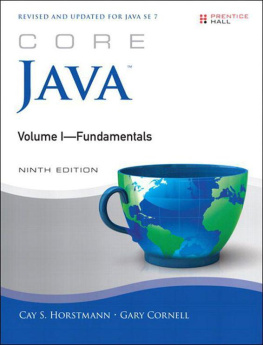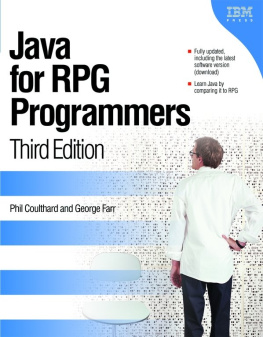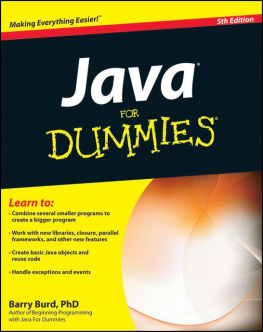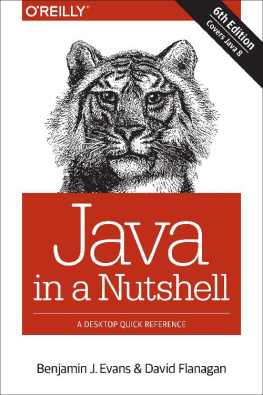About This eBook
ePUB is an open, industry-standard format for eBooks. However, support of ePUB and its many features varies across reading devices and applications. Use your device or app settings to customize the presentation to your liking. Settings that you can customize often include font, font size, single or double column, landscape or portrait mode, and figures that you can click or tap to enlarge. For additional information about the settings and features on your reading device or app, visit the device manufacturers Web site.
Many titles include programming code or configuration examples. To optimize the presentation of these elements, view the eBook in single-column, landscape mode and adjust the font size to the smallest setting. In addition to presenting code and configurations in the reflowable text format, we have included images of the code that mimic the presentation found in the print book; therefore, where the reflowable format may compromise the presentation of the code listing, you will see a Click here to view code image link. Click the link to view the print-fidelity code image. To return to the previous page viewed, click the Back button on your device or app.
Core Java
Volume IIAdvanced Features
Tenth Edition
Cay S. Horstmann

Boston Columbus Indianapolis New York San Francisco Amsterdam Cape Town
Dubai London Madrid Milan Munich Paris Montreal Toronto Delhi Mexico City
So Paulo Sydney Hong Kong Seoul Singapore Taipei Tokyo
The author and publisher have taken care in the preparation of this book, but make no expressed or implied warranty of any kind and assume no responsibility for errors or omissions. No liability is assumed for incidental or consequential damages in connection with or arising out of the use of the information or programs contained herein.
For information about buying this title in bulk quantities, or for special sales opportunities (which may include electronic versions; custom cover designs; and content particular to your business, training goals, marketing focus, or branding interests), please contact our corporate sales department at or (800) 382-3419.
For government sales inquiries, please contact .
For questions about sales outside the United States, please contact .
Visit us on the Web: informit.com/ph
Library of Congress Catalog Number: 2016952666
Copyright 2017 Oracle and/or its affiliates. All rights reserved.
500 Oracle Parkway, Redwood Shores, CA 94065
Portions 2017 Cay S. Horstmann
All rights reserved. Printed in the United States of America. This publication is protected by copyright, and permission must be obtained from the publisher prior to any prohibited reproduction, storage in a retrieval system, or transmission in any form or by any means, electronic, mechanical, photocopying, recording, or likewise. For information regarding permissions, request forms and the appropriate contacts within the Pearson Education Global Rights & Permissions Department, please visit www.pearsoned.com/permissions/.
Oracle America Inc. does not make any representations or warranties as to the accuracy, adequacy or completeness of any information contained in this work, and is not responsible for any errors or omissions.
ISBN-13: 978-0-13-417729-8
ISBN-10: 0-13-417729-0
Text printed in the United States of America.
1 16
Contents
Preface
To the Reader
The book you have in your hands is the second volume of the tenth edition of Core Java, fully updated for Java SE 8. The first volume covers the essential features of the language; this volume deals with the advanced topics that a programmer needs to know for professional software development. Thus, as with the first volume and the previous editions of this book, we are still targeting programmers who want to put Java technology to work in real projects.
As is the case with any book, errors and inaccuracies are inevitable. Should you find any in this book, we would very much like to hear about them. Of course, we would prefer to hear about them only once. For this reason, we have put up a web site at http://horstmann.com/corejava with a FAQ, bug fixes, and workarounds. Strategically placed at the end of the bug report web page (to encourage you to read the previous reports) is a form that you can use to report bugs or problems and to send suggestions for improvements to future editions.
About This Book
The chapters in this book are, for the most part, independent of each other. You should be able to delve into whatever topic interests you the most and read the chapters in any order.
In , you will learn all about the Java 8 stream library that brings a modern flavor to processing data, by specifying what you want without describing in detail how the result should be obtained. This allows the stream library to focus on an optimal evaluation strategy, which is particularly advantageous for optimizing concurrent computations.
The topic of hood when you use the object serialization mechanism, which makes saving and loading objects easy and convenient. We then move on to regular expressions and working with files and paths.
covers XML. We show you how to parse XML files, how to generate XML, and how to use XSL transformations. As a useful example, we show you how to specify the layout of a Swing form in XML. We also discuss the XPath API, which makes finding needles in XML haystacks much easier.
covers the networking API. Java makes it phenomenally easy to do complex network programming. We show you how to make network connections to servers, how to implement your own servers, and how to make HTTP connections.
covers database programming. The main focus is on JDBC, the Java database connectivity API that lets Java programs connect to relational databases. We show you how to write useful programs to handle realistic database chores, using a core subset of the JDBC API. (A complete treatment of the JDBC API would require a book almost as big as this one.) We finish the chapter with a brief introduction into hierarchical databases and discuss JNDI (the Java Naming and Directory Interface) and LDAP (the Lightweight Directory Access Protocol).
Java had two prior attempts at libraries for handling date and time. The third one is the charm in Java 8. In , you will learn how to deal with the complexities of calendars and time zones, using the new date and time library.
discusses a feature that we believe can only grow in importance: internationalization. The Java programming language is one of the few languages designed from the start to handle Unicode, but the internationalization support in the Java platform goes much further. As a result, you can internationalize Java applications so that they cross not only platforms but country boundaries as well. For example, we show you how to write a retirement calculator that uses either English, German, or Chinese languages.
discusses three techniques for processing code. The scripting and compiler APIs allow your program to call code in scripting languages such as JavaScript or Groovy, and to compile Java code. Annotations allow you to add arbitrary information (sometimes called metadata) to a Java program. We show you how annotation processors can harvest these annotations at the source or class file level, and how annotations can be used to influence the behavior of classes at runtime. Annotations are only useful with tools, and we hope that our discussion will help you select useful annotation processing tools for your needs.
and security managers for special-purpose applications. Then, we take up the security API that allows for such important features as message and code signing, authorization and authentication, and encryption. We conclude with examples that use the AES and RSA encryption algorithms.







